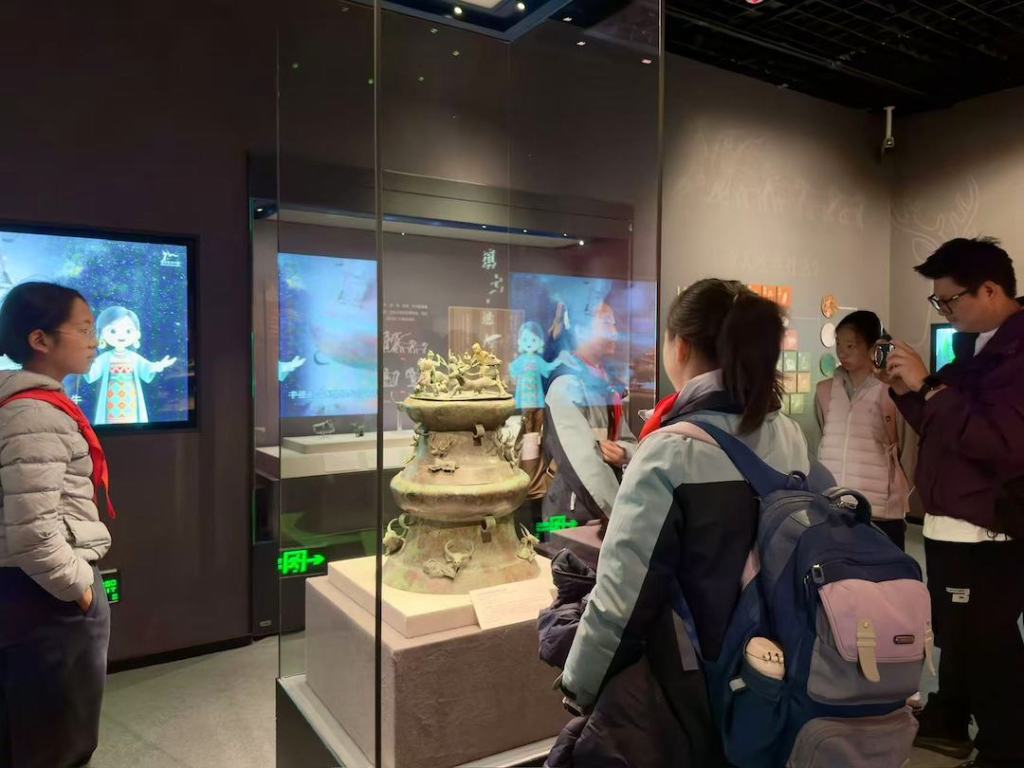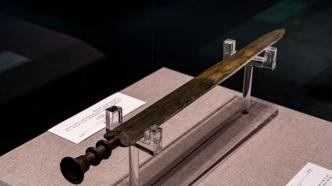
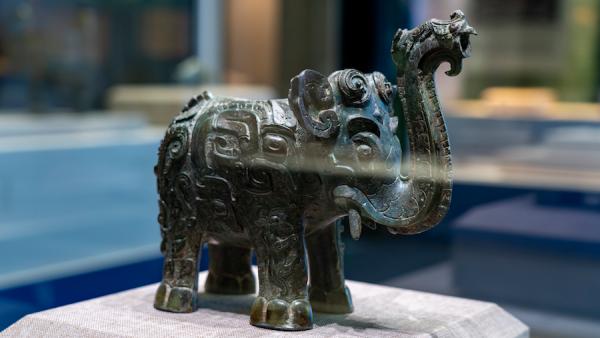
July 11 is China's Maritime Day. The China Maritime Museum's "Great Rivers and Seas: The Yangtze River and Marine Civilization·Exhibition of Archaeological Relics" was also officially exhibited to the public on the same day. Among the 180 cultural relics on display, there are only 64 first-class cultural relics. The "Fuchai Sword of King Wu" and "Luying Sword of Yue King" will be exhibited on the same stage. The only remaining bronze elephant statue of the Shang Dynasty in China, the Sanxingdui site is the most distinctive The bronze head of a human figure, the lacquer plate of "Ji Zha Hanging Sword Picture" in Zhu Ran's tomb, which is permanently prohibited from going abroad (territory), and the largest bronze drum discovered so far, "Guangnan Yuren Boat Pattern Bronze Drum" and other national treasure-level cultural relics are gathered together. It is no exaggeration to see all the archaeological achievements in the Yangtze River Basin for one exhibition.
The Paper learned that this exhibition is also an original special exhibition with the largest number of first-class cultural relics, the largest proportion of precious cultural relics, and the widest number of exhibitors since the opening of the China Maritime Museum.
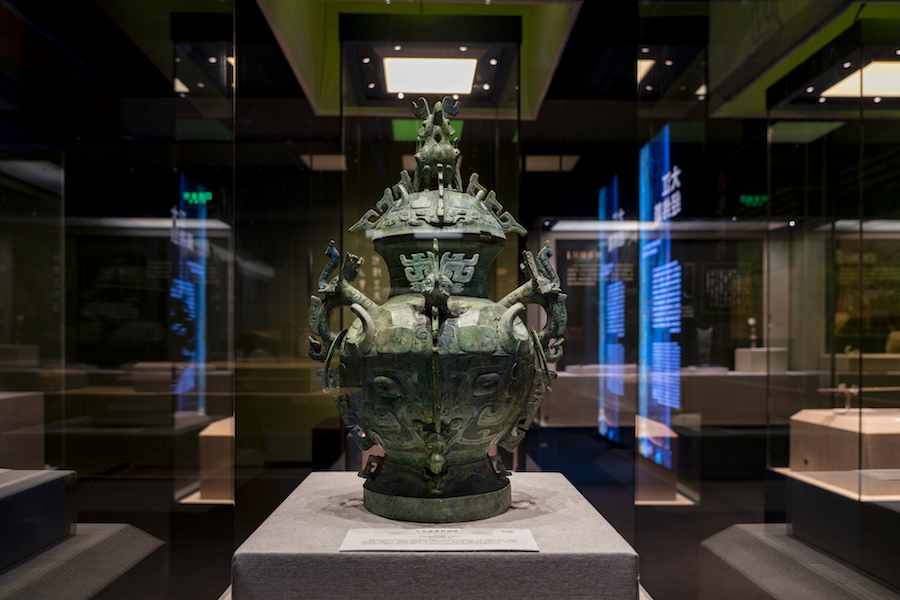
exhibition site
See all the Yangtze River archaeology in one exhibition
The exhibition is divided into four units: "The Land of Civilization", "The Longitude and Latitude of the Great River", "Sailing a Thousand Ports", and "Jianghai Interchange". There are 180 fine cultural relics on display, including 64 first-class cultural relics. A large number of national treasure cultural relics come to Shanghai for the first time. out.
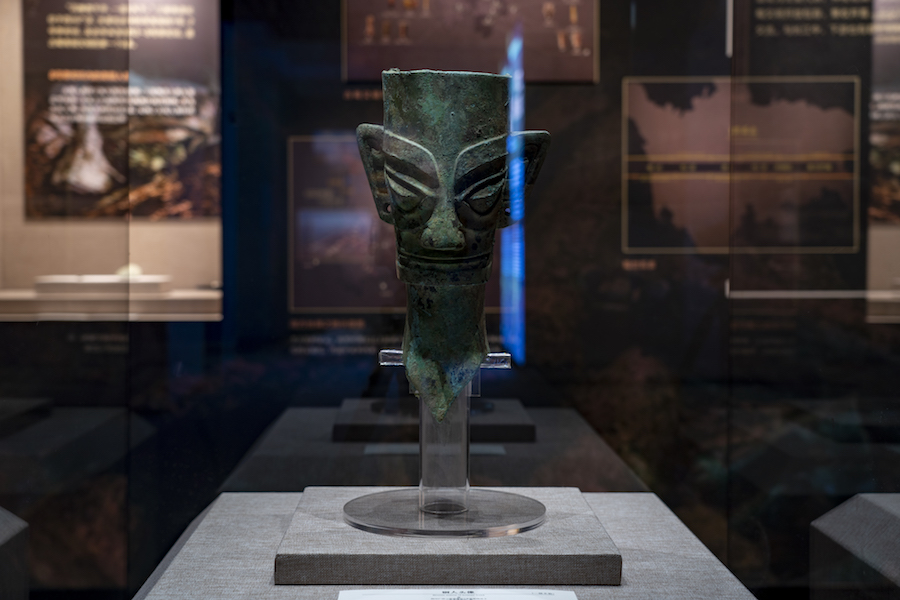
Bronze Human Head at the Exhibition Site, Shang, Unearthed from Sacrificial Pit No. 2, Sanxingdui Site, Guanghan, Sichuan, Collected by Sanxingdui Museum
The Paper reporter saw in the exhibition hall that this exhibition can be described as "star-studded". Almost all the important collections of important cultural and museum units in the Yangtze River Basin were present. The only surviving bronze elephant statue of the Shang Dynasty, the most distinctive bronze human head in the Sanxingdui site, the lacquer plate of "Jizha Hanging Sword Picture" in Zhu Ran's tomb, which is permanently prohibited from going abroad (territory), and the star cultural relic of the second season of "National Treasure" The "Eastern Han Dynasty Salt Portrait Brick", the largest bronze drum discovered so far, "Guangnan Bronze Drum with Featherman Boat Pattern" and other national treasures are gathered together.

Exhibition Site Drumming and Singing Figurines Unearthed from Yangzishan Tomb in Chengdu, Sichuan, Eastern Han Dynasty Collection of China Three Gorges Museum in Chongqing

Exhibition site Qin Painted flat pot with cow, horse and bird patterns Unearthed from Tomb No. 44 in Yunmengsuihudi, Hubei Province Collection of Hubei Provincial Museum
Almost every piece of cultural relics can involve an important domestic archaeological discovery, from the Shijiahe site, Lingjiatan site, Songze site, Sanxingdui site, Mawangdui Han tomb, Zenghouyi tomb, Haihunhou tomb, Zhuhai tomb, etc. From the tomb of Ran tomb, the tomb of Emperor Yang of the Sui Dynasty to the ruins of Qinglong Town, the latest archaeological discovery of the ancient ship "Yangtze River No. It is not an exaggeration to say that it has seen all the archeology of the Yangtze River in one exhibition.

Bronze Elephant Zun, Shang, Unearthed from Lion-shaped Mountain, Liling, Hunan, Hunan Museum Collection
Therefore, the name of the special exhibition is enough to attract people. According to Cai Tingting, librarian of the Exhibition Department of the China Maritime Museum and exhibition content planner, the exhibition focuses on presenting 34 major archaeological discoveries and their unearthed cultural relics, including 13 of the top 100 archaeological discoveries of the century, 15 of the top ten new archaeological discoveries of the year, and the spatial span From the upper, middle and lower reaches of the Yangtze River, the time span spans from the Neolithic Age to the Ming and Qing Dynasties.
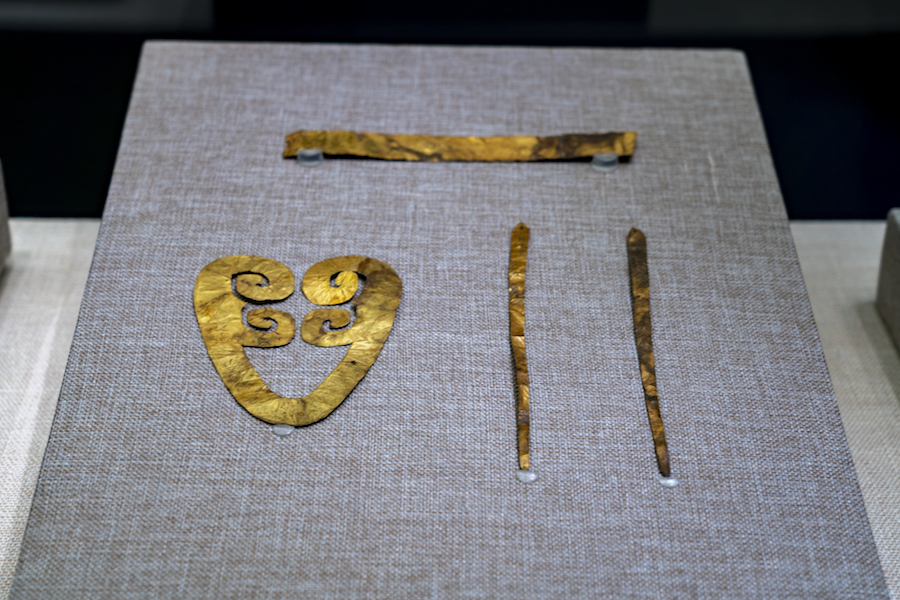
exhibition site
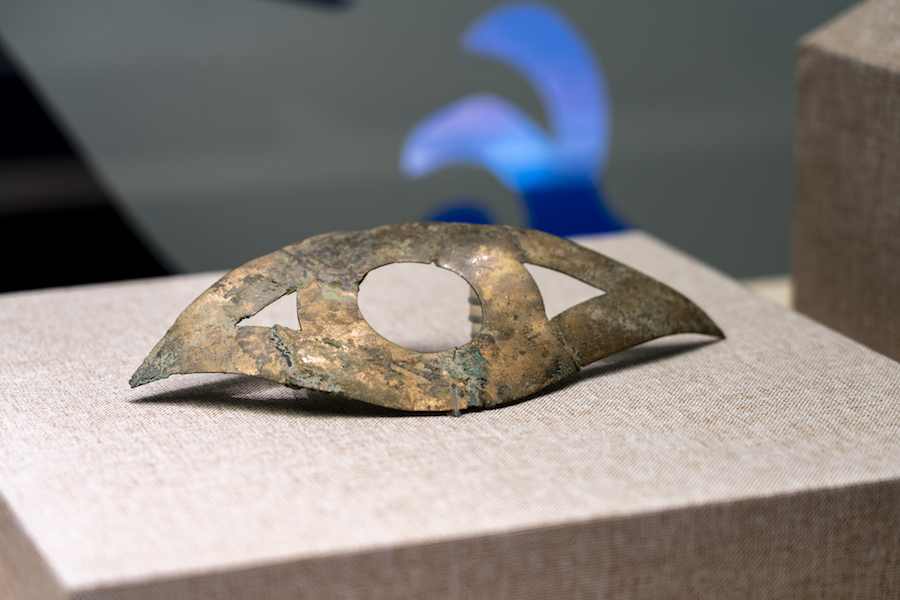
Hollow-out Copper Eye-Shapes at the Exhibition Site Unearthed from the sacrificial area of the Jinsha Site in Chengdu, Sichuan from the Late Shang Dynasty to the Western Zhou Dynasty Collected by the Jinsha Site Museum in Chengdu

exhibition site
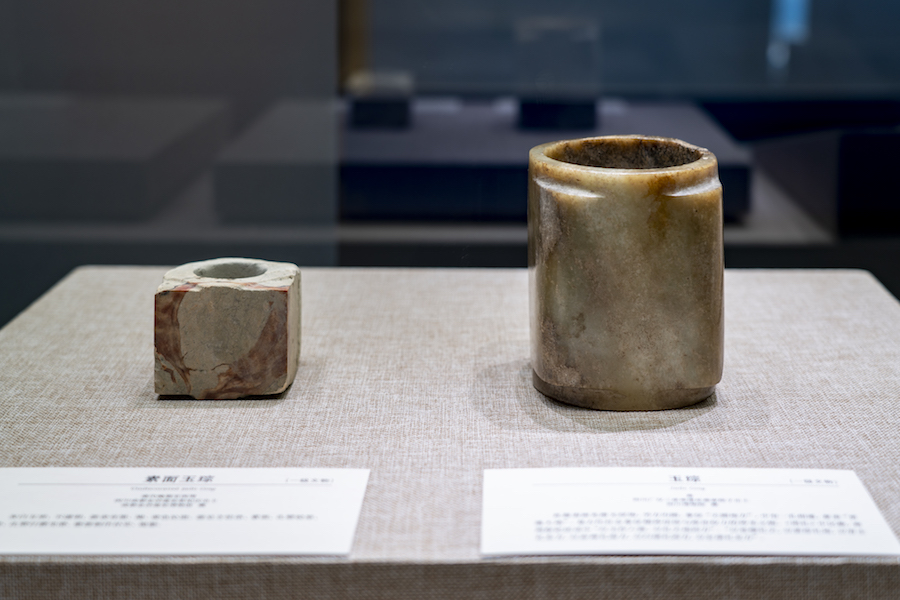
exhibition site
In addition to the "shining" exhibits in the exhibition hall, the exhibition layout is also very meaningful. For example, the cultural relics of the Sanxingdui site and the Jinsha site, which belong to the ancient Shu civilization, are placed side by side, and the similarities and differences between the two cultural relics are also presented on the exhibition boards. ; Another example in this exhibition is the juxtaposition of "Fuchai Sword, King of Wu" and "Luying Sword, King of Yue" on the same stage, creating a tense confrontation scene of "Wu and Yue struggle for hegemony". However, due to the schedule of cultural relics and cultural preservation requirements, the exhibition period of "Wu Wang Fucha Sword" is only one month, and the display cabinet for Wu Wangjian is still waiting for it. It will not be officially unveiled until September 8th at the China Maritime Museum.

The Sword of Yue King Luying (Zhezhi Yuyi) Warring States period Unearthed from Guanping Village, Yutai Township, Jingzhou, Hubei Province, collected by Jingzhou Museum
Presenting the interaction and exchange of the Yangtze River Basin and Jianghai civilization
The Yangtze River is the largest river in my country and is known as the "Golden Waterway". From Lingjiatan at the dawn of civilization, Kuahu Bridge where "China's first boat" was born, Sanxingdui, which shocked the world when it woke up, and Panlong City, the king's city of Shang... Numerous archaeological discoveries prove that, like the Yellow River, the Yangtze River is also an important origin of Chinese civilization. land.
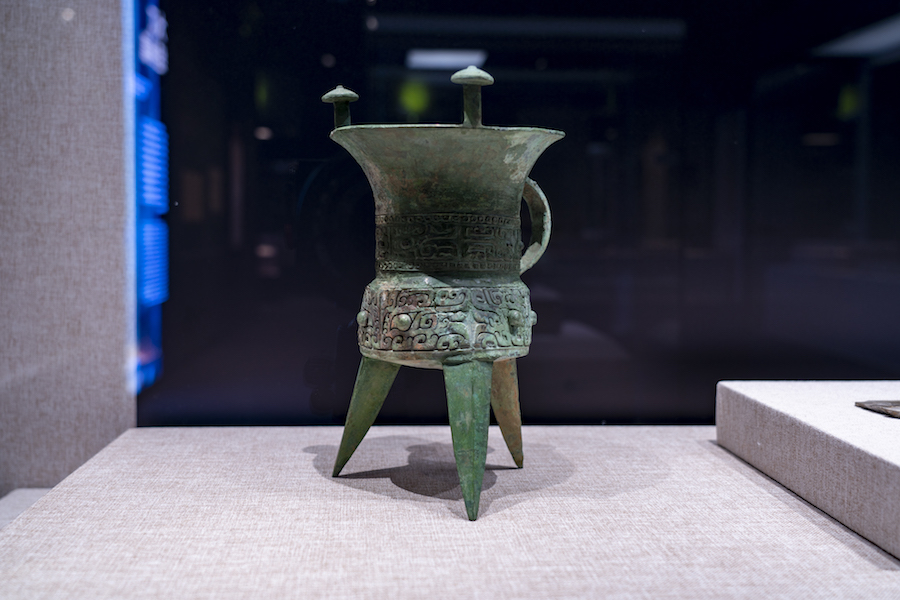
Shang·Tongzhu (jiǎ) Collected in Yangjiawan, Panlongcheng Ruins, Wuhan, Hubei, Panlongcheng Ruins Museum Collection
"As early as the Stone Age and the Bronze Age, the Yangtze River Basin has bred highly developed civilizations, and with the Yangtze River as a link, regional cultural exchanges have begun. With the comprehensive integration of Yangtze River shipping and the Maritime Silk Road and Land Silk Road The opening of the Yangtze River Basin has stimulated the interaction between the Yangtze River Basin and overseas civilizations more unprecedentedly.” Mao Min, curator of the exhibition and director of the Exhibition Department of the China Maritime Museum, told The Paper that this exhibition is based on major archaeological discoveries in the Yangtze River Basin , showing the magnificent civilization and shipping achievements of the Yangtze River Basin from the perspective of cultural relics, and telling the interaction and integration of the Yangtze River and marine civilization.
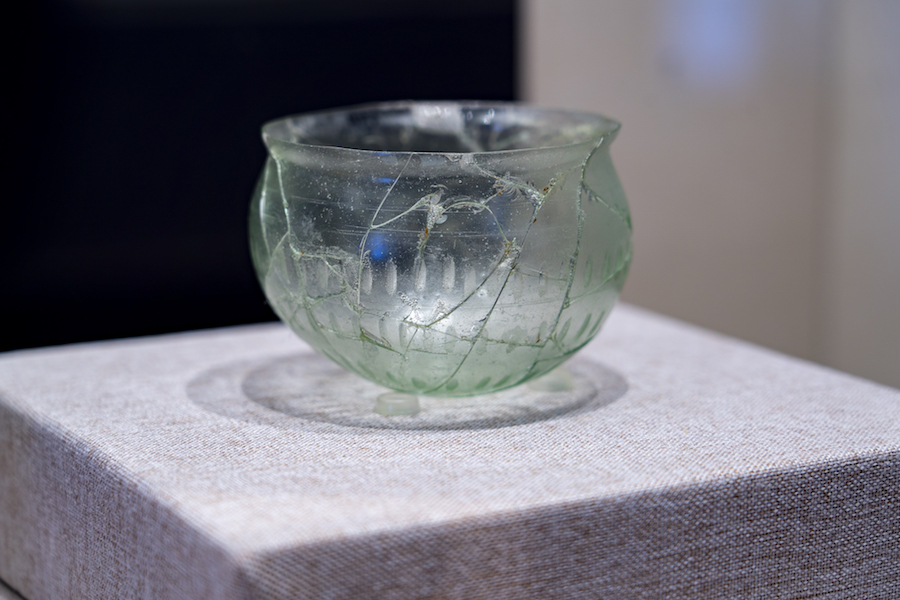
Eastern Jin Dynasty Glass Bowl Collection of Nanjing Museum
"Our curatorial team can be said to have traveled all the way up the river, borrowing exhibitions with different cultural institutions." Cai Tingting said. In terms of selection criteria for exhibits, in addition to fully considering the actual situation of the cultural relics of each brother unit and the exhibition schedule, it is mainly to serve the entire exhibition line. The selection can not only reflect local characteristics, but also reflect cultural exchanges between regions in the Yangtze River Basin and reflect the relationship between the Yangtze River and the ocean. Cultural relics that communicate and integrate with world civilizations, especially those related to shipping and boat culture.

Western Han Dynasty·Guangnan Bronze Drum with Feathered Man and Boat Pattern Unearthed from Azhangzhai, Guangnan County, Wenshan Prefecture, Yunnan Province Collection of Yunnan Provincial Museum
For example, as one of the treasures of the Yunnan Provincial Museum, the bronze drum with the pattern of feathers and people in the Guangnan of the Western Han Dynasty not only reflects the bronze smelting technology in Yunnan at that time, but also the utensils that best express the bronze culture of the Yunnan people at that time. The body of the drum is exquisitely patterned and engraved with four groups of feathered men racing across the river. The body of the drum is long and narrow and curved, reflecting the boat culture, shipbuilding technology and the development of water transportation in the Yangtze River Basin at that time.
For example, Wu State and Yue State are close to the Yangtze River and connected to the sea. They are water towns with rivers and rivers. The two countries conquered each other and successively claimed hegemony. The swords and swords in the Wuyue bronze wares are like Wu Wangjian and Yue Wangjian, reflecting the appearance of Wuyue ancestors who were good at boats and martial arts.
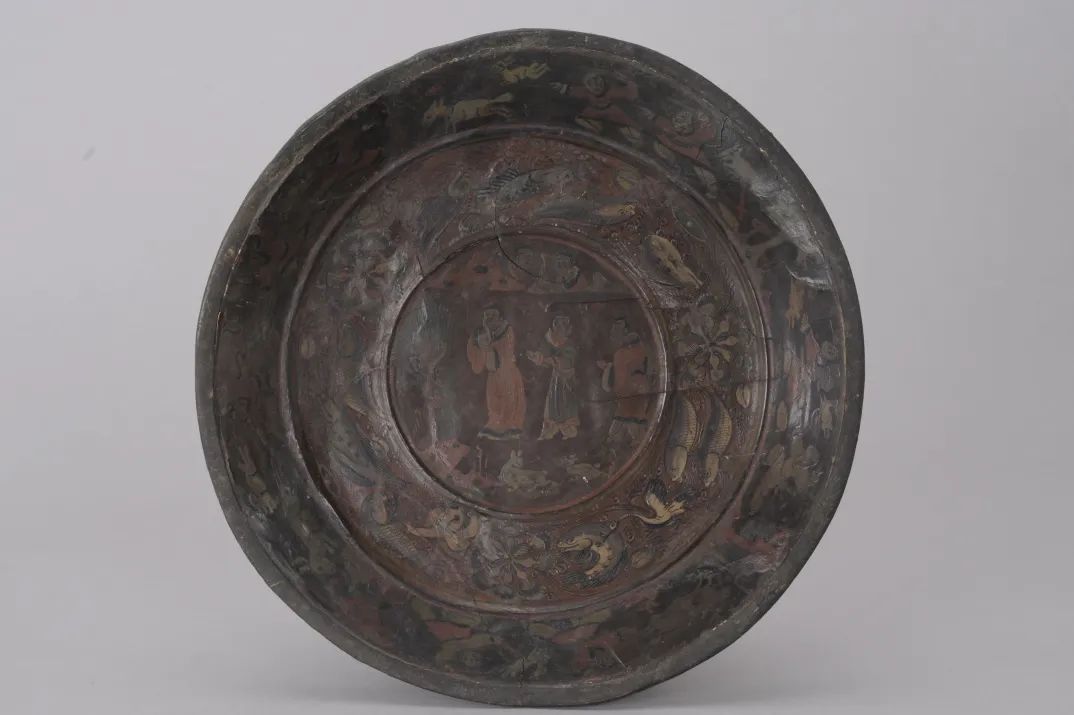
The lacquer plate with hanging sword picture of Jizha unearthed from the tomb of Zhu Ran in Ma'anshan, Anhui during the Three Kingdoms and Wu period
Another example is the lacquer plate with hanging swords in Jizha unearthed from the tomb of Zhu Ran in Ma'anshan, Anhui during the Three Kingdoms and Wu period. In the center of the disc is the historical story of Wu Gongzi's "Ji Zha Pendant, Xu Jun's Tomb Tree" in the Spring and Autumn Period, praising the noble sentiment of a gentleman who abides by faith. However, the five-character inscription "Shu Jun Zao Zuo Lao" written in vermilion lacquer on the bottom of the lacquer plate proves that its origin is in Shu.
"The lacquer ware produced in the Shu area finally appeared in the general's tomb of Dongwu in the lower reaches of the Yangtze River, which shows that although the upper reaches of the Yangtze River and the middle and lower reaches of the Yangtze River belonged to different forces, due to the connectivity of the Yangtze River shipping, the exchanges between the lower reaches of the Yangtze River and the middle and upper reaches were still very close. Closely." Cai Tingting said.

Porcelain bowl with water from the Black Stone at the exhibition site

Tang·Changsha Kiln Celadon-glazed Brown-spot Pasted Figure Pattern Pot Collected by Changsha Museum
In addition, the exhibited porcelains unearthed from the ancient ship "Yangtze River No. It is at the forefront of exchanges and dissemination of cultural mutual learning.
This year coincides with the 10th anniversary of the joint construction of the "Belt and Road" initiative. The museum hopes that this exhibition will not only use cultural relics to demonstrate and tell the blending process of "from the Yangtze River to the ocean" from the Neolithic Age to the present, but also demonstrate the outstanding contribution of the Yangtze River to world civilization. At the same time, it can also create a good cultural atmosphere for promoting the construction of the Yangtze River Economic Belt and the "Belt and Road".
The exhibition is guided by the Shanghai Municipal Transportation Commission, the Shanghai Municipal Bureau of Culture and Tourism (Shanghai Municipal Bureau of Cultural Relics), the Yangtze River Basin Museum Alliance, and the Special Committee of the China Association of Maritime Museums. 41 museums from 13 provinces and cities across the country participated in the exhibition. The exhibition will last until October 8th.
Introduction of key cultural relics:
1. Pottery pig

Pottery domestic pig, Neolithic Majiabang culture (about 5,800-5,300 years ago), unearthed from the Songze site in Qingpu, Shanghai, collected by the Shanghai Museum
The cultural relic was unearthed at the Songze site in Qingpu, Shanghai, one of the earliest places in Shanghai where humans lived, and is known as the birthplace of ancient culture in Shanghai. is of great significance. The appearance of pottery sculptures of domestic pigs is also of great significance for the study of the origin of livestock breeding.
2. Avatar of the Bronze Man
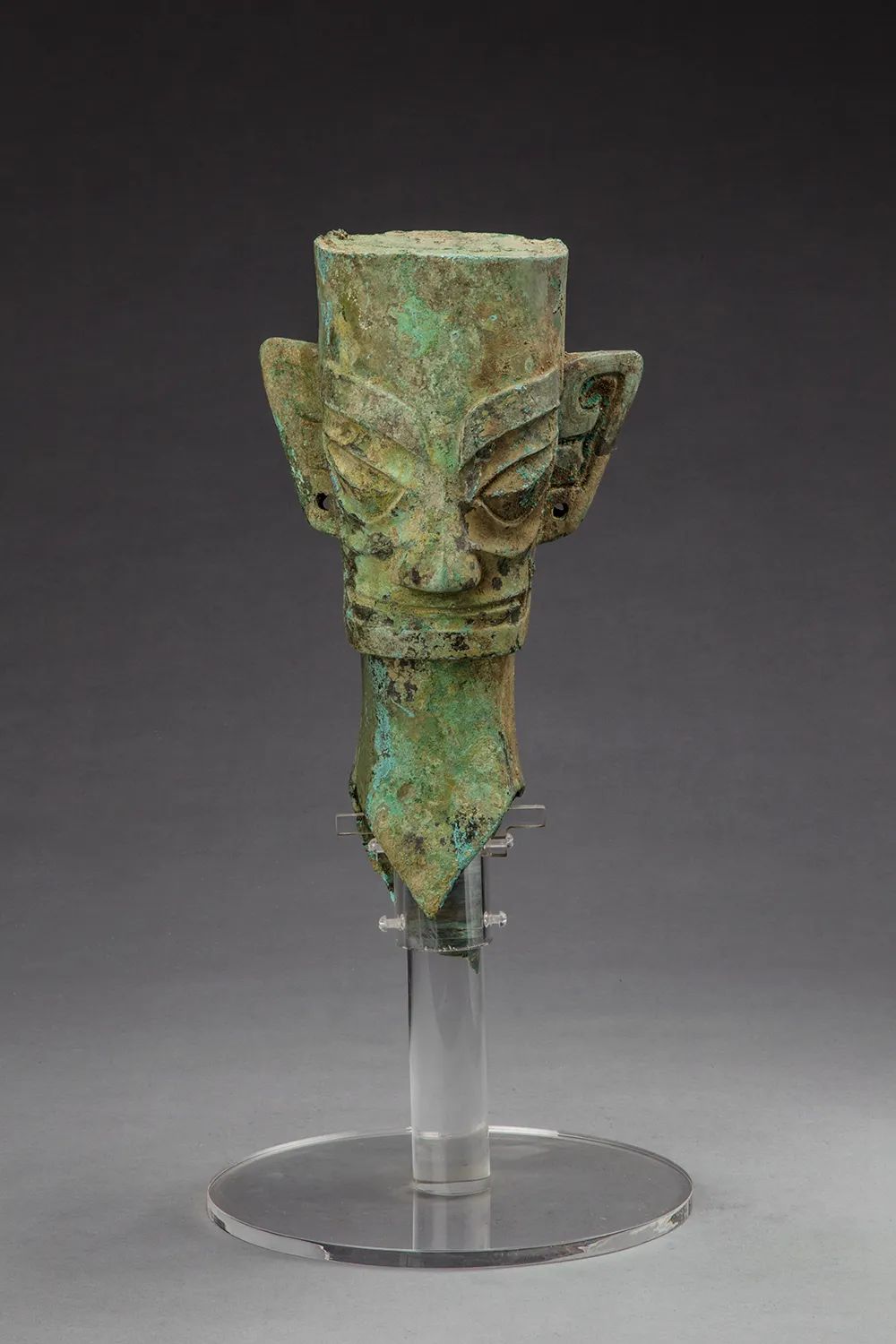
Bronze Human Head, Shang, Unearthed from Sacrificial Pit No. 2 at Sanxingdui Site, Guanghan, Sichuan, Sanxingdui Museum Collection
The head portrait is Fang Yi, with thick eyebrows, erect eyes, bulbous nose, wide mouth, big ears, and pierced earlobes; the neck is relatively thick, and the front and rear are in the shape of an inverted pointed angle; bundle. Bronze human heads are one of the most distinctive artifacts in the Sanxingdui site. These different shapes should be worshiped idols in sacrificial activities. They not only symbolize gods, earth, ancestor gods, etc., but also represent kings and wizards. The secular or spiritual leaders of the ancient Shu showed the social form of the unity of God, politics and religion in ancient Shu.
The ancient Shu people built a huge sacrificial system. A large number of bronze statues unearthed in Sanxingdui with strange shapes that are not seen in the Central Plains and other parts of the world, as sacrificial vessels connecting heaven and earth and communicating people and gods, reflect the ancient Shu people's unique aesthetic consciousness and Mystical religious beliefs.
3. Bronze Elephant

Bronze Elephant Zun, Shang, Unearthed from Lion-shaped Mountain, Liling, Hunan, Hunan Museum Collection
At present, only three bronze elephant statues of the Shang Dynasty have been found, and the other two have been lost overseas. This piece is also the only one with a clear place of origin. The statue is pictographic and is a wine vessel. The elephant trunk communicates with the abdomen, which can be used as a mouth, and there is an oval mouth on the back, from which wine can be poured. The vessel is decorated with dragon, phoenix, tiger, animal face and other patterns, especially the phoenix, bird and tiger patterns on the trunk, which can be described as unique. During the Yin and Shang Dynasties, the bronze casting technology brought by merchants going south brought Hunan into the Bronze Age. In the Xiangjiang River Basin, the exquisite Shang and Zhou bronzes with unique animal shapes and patterns unearthed in Ningxiang, Liling and other places revealed the mystery of the disappearing Fangguo, and were praised by academic circles as "the center of Shang and Zhou bronze culture in southern China".
4. Tiger-eared Kui-shaped bronze tripod with flat feet

Tiger-eared Kui-shaped Bronze Tripod with Flat Feet, Unearthed from the Shang Tomb in Xingan, Jiangxi Province, Jiangxi Provincial Museum
In the Ganjiang River Basin, the Wucheng Culture represented by Xingan Oceania and the Wucheng Ruins presents the appearance of the Southern Bronze Kingdom 3,000 years ago. Xingan Oceania is currently the large-scale Shang Dynasty tomb with the largest number and richest types of bronzes unearthed in China. Together with the Yinxu Fuhao Tomb and the Sanxingdui Sacrificial Pit, it is also known as the three major discoveries of Shang Dynasty bronzes. The bronze ritual vessels and weapons in Xingan Oceania are obviously influenced by the Shang culture of the Central Plains, and also have obvious local characteristics. This kind of bronze tripod decorated with tigers is unique to the Yangtze River Basin. The tiger is a symbol of the indigenous bronze culture in Jiangxi in the Shang Dynasty, showing the unique local tiger worship, and the flat-footed shape is also a feature of the southern bronzes in the Yangtze River Basin.
5. Standing bird cover hanging bell copper 罍 (léi)

Bronze jar (léi) with standing bird cover and hanging bell, early Western Zhou Dynasty, unearthed from Tomb No. 27, Yejiashan Cemetery, Suizhou, Hubei, collected by Suizhou Museum
The ancestor of Zeng State was Nangong, an aristocrat in the early Zhou Dynasty. Zeng State was an important feudal state entrusted to the south by Zhou kings in the early Western Zhou Dynasty. Yejiashan Cemetery is the cemetery of Zeng Hou in this period. The cover is covered with a standing bird, with the head of an animal standing beside the ears, and the fully carved animal head protruding from the neck. Combined with the wide, flat and exaggerated edge of the door, it is very decorative. The animal head is welded on the shoulder and the bell hangs on the outsole. The production level is relatively high. Bronze pots with a similar style were also unearthed from the Zhuwa Street cellar in Pengzhou, Sichuan.
6. Wu Wang Fuchai Sword (exhibition time 9.8~10.8) Late Spring and Autumn Period, Suzhou Museum Collection
The state of Wu possesses superb sword-casting skills, and the famous general Mo Xie was the sword-casting master of the state of Wu at that time. Wu and Yue respected martial arts and despised death, and the bronze weapons were rich in quantity and fine in quality, which is a true portrayal of the alliance between Wu and Yue for hegemony. This Wu Wang Fu Chai sword is 58.3 cm long, with smooth lines and natural points of the sword. The longest and best preserved.
This sword adopts a variety of crafts such as inlaying gold, inlaying, casting inscriptions, and inscriptions. There is a thin layer of blue rust on the surface. A masterpiece of mosaic technology. The turquoise stones engraved on the sword hoop are as small as sand grains and are neatly arranged, and the technique is also a unique skill that has been lost. The head of the sword is cast with eight circles of exquisite, steep and deep concentric circular ridges, which is one of the most acclaimed "Three Wonders of Wuyue Bronze Swords".
7. The King of Yue’s Lu Ying (Zhou Zhi Yu Yu) Sword

The Sword of Yue King Luying (Zhezhi Yuyi) Warring States period Unearthed from Guanping Village, Yutai Township, Jingzhou, Hubei Province, collected by Jingzhou Museum
There are gold inscriptions on both sides of the sword grid of this sword. The obverse reads "Yue Wang Yue Wang", and the reverse reads "Zhou Zhi Yu Yu", which means Lu Ying. According to the "Bamboo Book Chronicles", Lu Ying was the son of Goujian, king of Yue, and reigned from 464 BC to 459 BC. The Wuyue area likes to engrave dark patterns on the weapons. This decoration method was first seen in the Western Zhou Dynasty. The round stem of the sword also has a strong Wuyue cultural factor, which has become popular in the Wuyue area in the late Spring and Autumn Period. This sword was found in Chu, which may be due to war, courtesy and other reasons.
Wu State and Yue State are close to the Yangtze River and connected to the sea. They are water towns with criss-crossing rivers and rivers. The two countries conquered each other and successively claimed hegemony. The shadows of swords and swords in Wuyue bronzes reflect the appearance of Wuyue ancestors who were good at boats and martial arts.
8. Bronze dove (jiū) staff
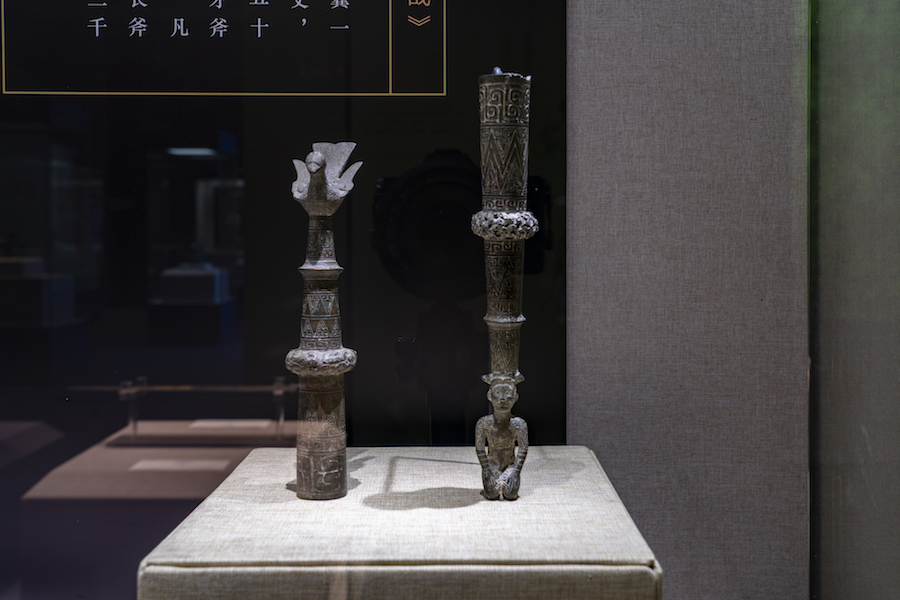
Bronze Dove (jiū) Staff, Spring and Autumn Period, Unearthed from Lizhu Town, Shaoxing, Zhejiang, Collection of Keqiao District Museum, Shaoxing City
The dove stick is something used by the elderly with certain power. In the pre-Qin period, the old man was given a few sticks to show respect for the elderly and provide for the elderly. This stick is composed of three parts: the head, the body and the forging. It has beautiful shape, complicated decoration and exquisite technique. There is a dove bird on the top of the head of the staff, with a short beak and tail, and its wings are ready to fly. The whole body is decorated with feather patterns. This custom of worshiping doves originated from the worship of bird totems in the Yue Kingdom. The kneeling figure at the bottom of the stick is upsetting, with the hair growing to the front of the forehead and ears, a bun on the back of the head, and a hairpin across it. The body is decorated with geometric patterns, cicada patterns, etc., and the waist is tied around. The custom of cutting off hair tattoos". The head of the stick and the middle part of the upsetting stick are both flat and openworked, and the patterns of coiled beetles, cicada wings, and clouds and thunder are harmoniously combined.
9. Copper shell storage for animal fight scenes

Bronze shell storage device for animal fighting scenes, Western Han Dynasty, unearthed from ancient tombs in Shizhaishan, Jinning District, Yunnan Province, collected by Yunnan Provincial Museum
The shell container is named after it was full of shellfish when it was unearthed. The top cover of some shell container is cast with a rich image, which contains a lot of information about the Dian people. It is one of the typical artifacts of Shizhaishan culture. This vessel is cylindrical in shape with a central waist. The cover and body are connected by a female mouth. There is a tiger-shaped ear on each side, and four dog-shaped feet at the bottom of the vessel. The top and bottom of the body are decorated with spiral patterns. Covering the scene of tiger and bull fighting, there is a tree in the middle, and monkeys and birds stand on the tree.
10. "Jun Xingshi" Lacquer plate with raccoon and tortoise pattern

"Jun Xingshi" lacquer plate with raccoon and tortoise pattern, Western Han Dynasty, unearthed from Han Tomb No.
Located in Changsha, Hunan Province, Mawangdui Han Tomb is the most complete Han Dynasty princely tomb group in Hunan. The scale is grand, and a wealth of funerary artifacts such as exquisite weaving and embroidery, lacquerware, and silk scripts have been unearthed.
The lacquerware unearthed from the Mawangdui Han Tomb is numerous, exquisitely made, gorgeously decorated, and as shiny as new, which shows the development of the lacquerware manufacturing industry in the Yangtze River Valley in the early Han Dynasty. This lacquer ware is made of rotating wood, with three cats and a turtle painted on the black lacquered floor inside the plate, and the book "Jun Xingshi" written in Zhu. The cat is outlined with a single line of red paint, painted with gray-green paint inside, and painted with red ears, whiskers, mouth, eyes, claws, teeth and soft fur. The picture particularly highlights the cat's wide-open eyes, long tail and turtle's long neck. vivid. The tortoise represents longevity and was regarded as auspicious at that time, and was called the "Four Spirits" together with the dragon, phoenix and lin. The combination of cat and tortoise reflects people's wish to prolong life at that time.
